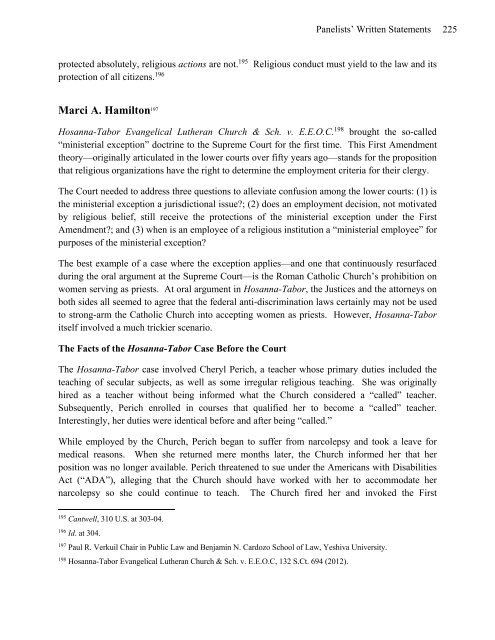PEACEFUL COEXISTENCE
2cgDkdT
2cgDkdT
Create successful ePaper yourself
Turn your PDF publications into a flip-book with our unique Google optimized e-Paper software.
Panelists’ Written Statements<br />
227<br />
The Supreme Court also declined to embrace a “church autonomy doctrine.” The corollary to<br />
the jurisdictional argument was a theory that churches have “autonomy” from discrimination<br />
law. This theory has been endorsed by numerous church lawyers in a wide variety of settings,<br />
but as I explained in my amicus brief in this case on behalf of BishopAccountability.org, The<br />
Cardozo Advocates for Kids, Child Protection Project, The Foundation to Abolish Child Sex<br />
Abuse, Jewish Board of Advocates for Children, Inc., KidSafe Foundation, The National Black<br />
Church Initiative, The National Center for Victims of Crime, Survivors for Justice, and the<br />
Survivors Network of those Abused by Priests and below, the Supreme Court has never embraced<br />
or identified a “church autonomy doctrine,” 203 and did not do so in this case. In fact, only two<br />
members of the Court, and two who rarely see eye-to-eye on any subject, Justices Alito and<br />
Kagan, endorsed an “autonomy” approach. 204<br />
The Hard Question Largely Left Unanswered: Who is a “Minister”?<br />
Because the Court did not side with the church’s argument in favor of a jurisdictional rule, but<br />
embraced the concept of a ministerial exception required by the First Amendment, it was forced<br />
to decide which employees of religious organizations qualify for the exception. One bright line<br />
would have been to limit it to ordained clergy, but the Court declined to limit the class of those<br />
employees affected to only those who are obviously ordained clergy. The Court also declined to<br />
hold that each and every employee of a religious institution is included. As usual, the hard part<br />
in a constitutional case is the line-drawing.<br />
The lower courts struggled with this same line-drawing, which is why, in the end, the Supreme<br />
Court took up the issue. Essentially the Court held that if an employee is a “minister,” he or she<br />
is excluded from the protections of federal civil rights law. Accordingly, if Perich were not a<br />
“minister,” she would have received the full protection of the ADA, Title VII, and every other<br />
federal, state, and local anti-discrimination law, despite the fact that her employer was religious.<br />
In a Supreme Court case, the most important argument that any litigant can offer is a workable<br />
test. Here, after the Court rejected the jurisdictional theory and a bright-line ordained clergy<br />
category, the test would need to resolve who is, and is not, a minister. Yet, no compelling test<br />
was put forward by either side in Hosanna-Tabor, or, in fact, the Court. For employees who are<br />
not ordained clergy, each case in the future will be based on the facts of that case.<br />
203<br />
Brief of BishopAccountability.org et al. at 17, as Amici Curiae Supporting Petitioner, Hosanna-Tabor Evangelical<br />
Lutheran Church & Sch. v. E.E.O.C, 132 S.Ct. 694 (2012).<br />
204<br />
Hosanna-Tabor, 132 S.Ct. at 711-716 (Alito, J., concurring).


